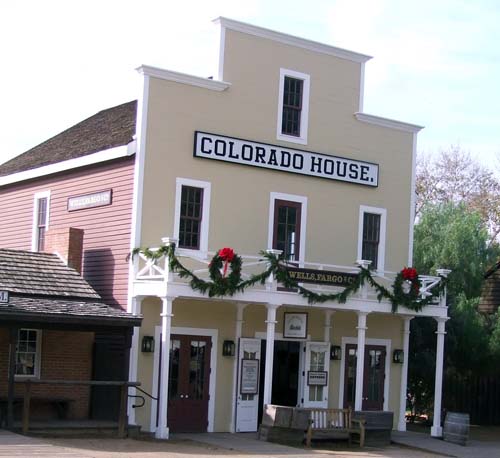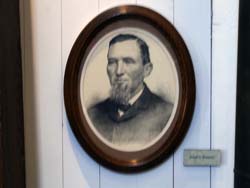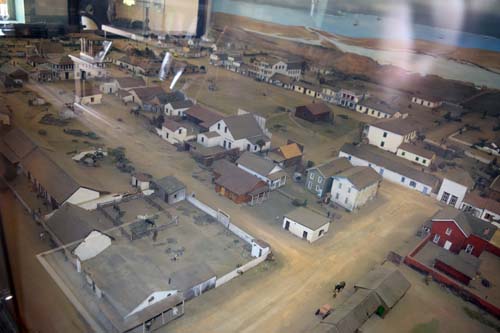
-Tenth in a series-
Exit 3, Taylor Street, San Diego ~ Colorado House, Old Town San Diego State Historic Park
By Donald H. Harrison


SAN DIEGO –Inside the false-front Colorado House, one may get the false impression that Joseph S. Mannasse spent most of his life as an agent for the Wells Fargo Company. In fact, that was but a sidelight of the Jewish merchant’s career as a businessman and civic leader.
Today, we associate the Colorado House with Mannasse because his photograph hangs inside, but in fact, his thriving Joseph Mannasse & Co. general store had been situated on the other side of Old Town facing Juan Street and backing on the small street that was called Camino de los Judios (Jews’ Street). The back doors of the stores of several (but not all) Jewish merchants could be accessed from it. Depending on which side of the Camino the stores were situated, they fronted either on the Plaza or Juan Street.

Joseph Mannasse and his partner Marcus Schiller imported their supply of goods from the import-export warehouses of San Francisco, to which merchandise was brought by ship from the East Coast of the United States, Latin America, and Asia. Gathering goods of every description—ranging from clothing to tools to foods and perfumes—Mannasse and Schiller crammed into their store everything that pioneer families needed or wanted . Its bulging shelves represented the department store of its day, and here customers not only shopped, but traded gossip and news.
In the West of the mid 19th century, very few people had money. So to pay for these goods, ranchers would pledge to Mannasse and Schiller a share of their profits when the cattle was driven to market, or, failing that, a percentage of their herds. In time, the merchants had so many cattle, the livestock pens adjacent to their store could no longer keep them all. So they decided to purchase two ranchos where the cattle could roam freely – Rancho Los Encinitos and Rancho San Dieguito. Had their families held onto that land, they would own most of the areas that today are known as Solana Beach, Rancho Santa Fe, Encinitas and Carlsbad. Today anyone who owned that much land would be a multi-billionaire, but back in those days open ranch land was fairly inexpensive. One could buy it cheaply, and unfortunately, later one could sell it just as cheaply.
The business partners were responsible for creating a stage coach line that ran between San Diego and Los Angeles, and a remnant of one of the intermediate stage houses – a crumbling wall of adobe—can still be seen today at Stagecoach Park in Carlsbad, California.
Like many merchants, Mannasse and Schiller took an interest in civic affairs. The City Board of Trustees had remained dormant in the years following the United States Civil War. When entrepreneur Alonzo Horton came to San Diego, he liked what he saw and decided he wanted to buy some land along a middle portion of the bay, in the area that we today call downtown San Diego. When he inquired how he could do this, he was told that he would need to first arrange an election for a new City Board of Trustees, and then ask the trustees to agree to an auction of public land.
Horton persuaded Ephraim Morse, Thomas Bush and Joseph S. Mannasse to run for the positions, which, unopposed, they all won. Then at his request, they scheduled an auction of public land. He purchased 960 acres for $2,165, which amounted to 27 ½ cents per acre.
A year later, Marcus Schiller replaced his partner Joe Mannasse on the Board of Trustees. His was the board that voted in 1868 to set aside 1,400 acres for a city park. Many years later, in anticipation of the 1915 opening of the Panama Canal, San Diego held a contest to name the park, and the winning entry was “Balboa Park.” The Spanish explorer Vasco Nuñez de Balboa had been the first European to cross the Isthmus of Panama from the Atlantic Ocean to the Pacific Ocean, so the name was apropos, although Balboa never himself saw San Diego.
Today, the Laurel Street Bridge entrance to Balboa Park has a plaque on the gateway on which the mythical personages Atlantic and Pacific are depicted nearly touching hands. The plaque celebrates the foresight of Schiller and his fellow trustees Jose Guadalupe Estudillo and Joshua Sloane in setting aside the land.
Mannasse and Schiller purchased a share in a ship that traveled up and down the coast between San Diego and San Francisco, their intention to assure favorable delivery for their goods and to cut costs. Additionally, they built a wharf in Horton’s Addition, as downtown San Diego then was known.
In addition to their partnership in business, Mannasse and Schiller had an interesting family connection. Schiller’s sister, Hannah, married Hyman Mannasse, who was Joseph’s brother. Hyman moved to Arizona, where he was later killed in a holdup. Subsequently, Joseph Mannasse married Hannah, thus becoming his partner’s brother in law.
Although Schiller was the junior partner in their business, he was the senior official in San Diego’s budding Jewish community. He served as president of Adath Jeshurun (Gathering of the Faithful), which is what the congregation was called when it had no permanent place of worship. When the Jewish community had grown sufficiently to warrant the construction of a temple at which High Holy Day services were conducted in 1889, the congregation changed its name to Beth Israel (House of Israel). Marcus Schiller served as the president of both these congregations, providing continuity.
*
Next: The courthouse and the Franklins
*
Harrison is editor of San Diego Jewish World. You may comment to him at donald.harrison@sdjewishworld.com, or post your comment on this website, provided that the rules below are observed.
__________________________________________________________________
Care to comment? We require the following information on any letter for publication: 1) Your full name 2) Your city and state (or country) of residence. Letters lacking such information will be automatically deleted. San Diego Jewish World is intended as a forum for the entire Jewish community, whatever your political leanings. Letters may be posted below provided they are responsive to the article that prompted them, and civil in their tone. Ad hominem attacks against any religion, country, gender, race, sexual orientation, or physical disability will not be considered for publication. There is a limit of one letter per writer on any given day.
__________________________________________________________________